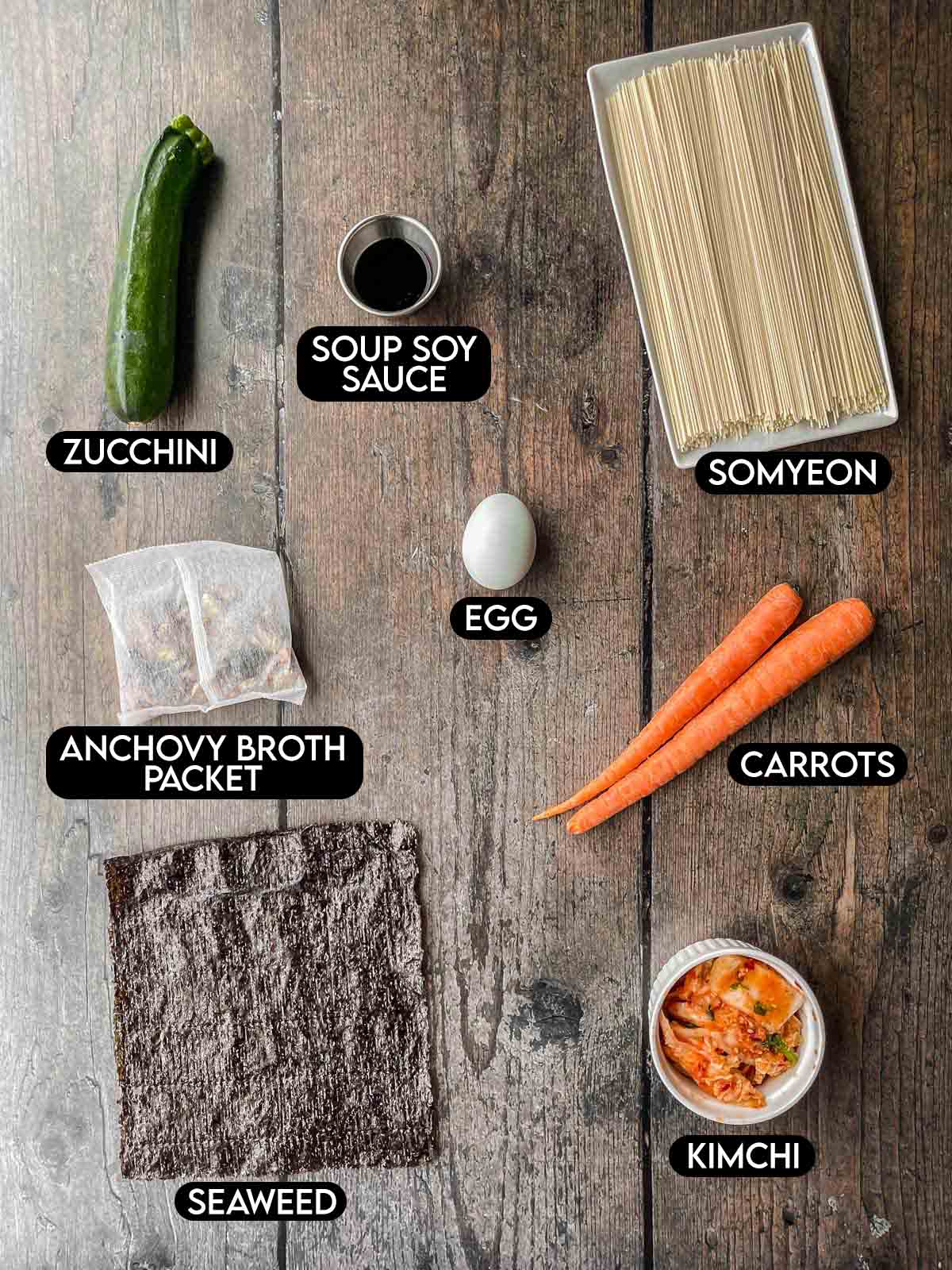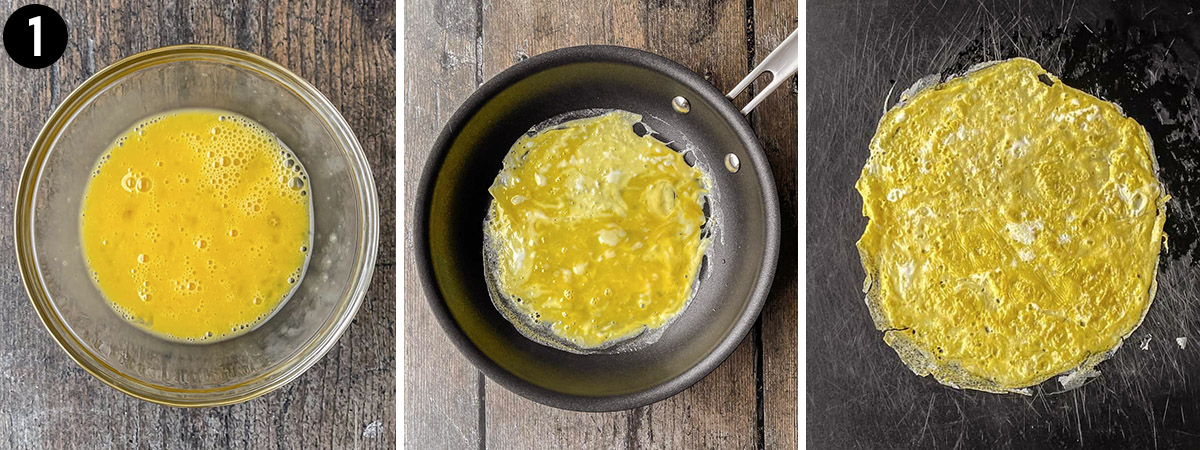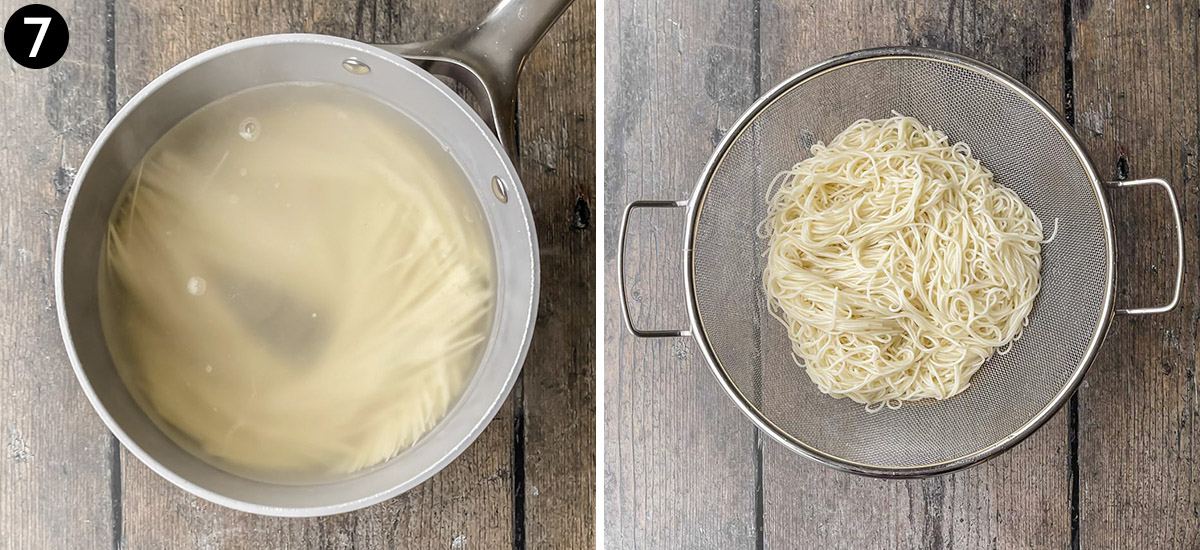Janchi Guksu (Korean Banquet Noodles) is a simple and comforting Korean noodle soup that's easy to customize. It's traditionally made with thin wheat noodles in a clear anchovy broth and topped with a delicious medley of vegetables. It’s the perfect dish to warm you up on a cold night!

Jump to:
🍜 What Is Janchi Guksu?
Janchi Guksu (or Gooksoo), 잔치국수, is a traditional Korean noodle soup that's often served at festive occasions such as weddings, birthdays, and New Year celebrations.
Janchi translates to "feast" or "banquet", which references the celebrations this dish is often served at. Meanwhile, guksu means "noodles" - so Janchi Guksu directly translates to "banquet noodles". In Korean culture, noodles symbolize a long and happy life, which is why this dish is often served at celebrations like weddings and birthdays.
Korean Banquet Noodles are irresistibly delicious and comforting! The warm and salty anchovy broth is perfectly light, clean, and fragrant. When paired with thin wheat noodles and matchstick vegetables like carrots and zucchini, Janchi Guksu is a healthy yet filling dish that will warm you from the inside out!
Janchi Guksu is a super easy recipe you can easily make for a quick weeknight meal. But it's also special enough to serve during holidays, special occasions, and celebrations. Serve it alongside Bulgogi Udon, Korean Shrimp Tacos, and Jumeokbap (Korean Rice Balls) to make it a true party!
Why You'll Love It
- Healthy: Janchi Guksu is a simple yet balanced and nourishing meal. The traditional somyeon noodles are made of whole wheat flour, which provides fiber and keeps you full longer. The clear broth is also low in fat and calories, while the veggie toppings provide vitamins and nutrients.
- Quick and easy: This straightforward Korean noodle soup comes together in less than an hour! It’s an excellent meal to make on weekdays when you’re short on time or make in advance for meal prep.
- Comforting: Janchi noodles in a warm anchovy broth is wonderfully warm and cozy. It's perfect for cold nights or when you're feeling under the weather.
🧂 Ingredients

- Somyeon (somen): These thin wheat flour noodles are great in both hot and cold dishes, such as Bibimmyeon (Korean Cold Spicy Noodles). They're best prepared near the end of the recipe so you can enjoy them at peak freshness.
- Anchovy broth packets: Korean recipes commonly use anchovy broth the way Western recipes use chicken broth. To make anchovy broth in minutes, use pre-made seasoning packets or tablets that contain dried anchovy and seaweed (kelp). There are several variations that also include dried shrimp or additional vegetables for flavor. Each brand will taste different so experiment to see which one you like the most. Find anchovy broth packets at Asian grocery stores or Amazon.
- Soup soy sauce (guk-ganjang): Soup soy sauce is different from regular soy sauce. It's specifically used to season soup-based dishes. It has a stronger, saltier flavor and lighter color than regular soy sauce. Many Korean households make their own soup soy sauce, but you can also find it at Korean grocery stores or on Amazon.
Toppings
You can top Janchi Guksu with any vegetable or toppings! However, the most traditional are egg, zucchini, carrots, and kimchi.
- Carrots: You can julienne the carrots yourself or use pre-shredded carrots to save time.
- Egg: Thin strips of egg provide protein, color, and a chewy bite. It's a popular topping in Korean soups like Dduk Mandu Guk (Korean Rice Cake and Dumpling Soup).
- Zucchini: Cut it into slightly larger pieces than the carrots. Since they're so porous, they'll cook quickly but we don't want it to become too soft and mushy.
- Kimchi: Spicy fermented cabbage that's a Korean staple. They are several different kinds but cabbage (baechu) kimchi is by far the most popular. Choose your favorite vegetable kimchi and level of spice, then chop into bite-sized pieces for Janchi Guksu.
- Seaweed and sesame seeds: You can cut toasted seaweed sheets (nori) that's used for kimbap, sushi, and Spam Musubi. Alternatively, use furikake, a seaweed seasoning that contains seaweed, sesame seeds, and additional seasonings.
- Cooking oil: To lightly sauté the vegetables. Avocado oil is my favorite oil to cook, fry, and sauté with because of its high smoke point (500°F) and neutral flavor.
Seasoning Sauce (Yangnyeomjang)

The seasoning sauce for Janchi Guksu is optional. Serve it on the side to dip your noodles in, or pour a little into the broth for more flavor.
- Soy sauce: Use regular low-sodium soy sauce (not the soup soy sauce) this time.
- Aromatics: Fresh garlic and green onion adds bright flavor.
- Gochugaru: Korean chili powder that's a little spicy, sweet, and smoky. It has a flavor profile of its own so I wouldn't recommend a substitute.
- Rice wine vinegar: A touch of bright acidity to balance the flavors in Korean Banquet Noodles.
- Sesame oil and sesame seeds: Adds richness and a nutty profile. Toasted or roasted versions will have more flavor.
Substitutions & Variations
- Elevate your Janchi Guksu with homemade anchovy broth. Or you can substitute it with chicken, beef, or vegetable broth. If so, leave out the water and bring your broth to a boil, then season with soup soy sauce.
- If you can't find soup soy sauce, halve the amount and use regular soy sauce, then season to taste with salt. Option to add a sprinkle of MSG if available.
- Feel free to add more protein! Shredded beef is a very popular topping for Korean Banquet Noodles. You could also add tofu, chicken, or fish cakes (eomuk).
- Add your favorite vegetable to the toppings. Thinly sliced radish, cabbage, or mushrooms would be delicious.
- To make vegetarian Janchi Guksu, substitute the anchovy broth with vegetable broth and use a vegetarian kimchi. For a vegan version, leave out the egg as well.
👩🏻🍳 How To Make Janchi Guksu
⬇️ Please scroll down to the recipe card to see full ingredient amounts and instructions.

STEP ONE: First, prepare the toppings. Whisk the egg and heat a skillet over medium heat. Pour egg in and tilt pan to make a thin a layer, then season with salt and pepper. Cook without moving for 2-3 minutes each side, then transfer to cutting board. Cut into thin strips and set aside.

STEP TWO: To the same skillet, add sliced zucchini with a pinch of salt. I usually don't add more oil but you can if needed. Cook for 3-5 minutes until tender, stirring occasionally. Then transfer to plate and set aside.
STEP THREE: Add a splash of oil, along with the carrots and a pinch of salt. Cook for 6-8 minutes, stirring occasionally, until tender. The time will depend on the size and thickness of your carrots. Transfer to a plate and set aside.
STEP FOUR: If you haven't already, prepare the rest of your toppings. Everything should be thinly sliced and bite-sized. Set aside while you work on the broth and noodles.

STEP FIVE: Next, prepare the broth for Janchi Guksu. Pour 8 cups water into a large pot and bring to a rolling boil. Turn the heat off and add the anchovy broth packet.
Let steep for 2-5 minutes, depending on your preference. Taste every 30 seconds and take out the packet when you're happy with the seafood flavor. Take it out earlier than you think - it's easy to add the bag back in but it's hard to take away the flavor if it steeps for too long.
STEP SIX: Then pour in soup soy sauce and salt. Season to taste, then cover with a lid and keep warm on medium-low heat until ready to serve.

STEP SEVEN: When you're ready to serve, bring a pot of water to a boil and generously salt. Cook somyeon noodles according to package instructions, then drain. Rinse with cold water to prevent clumping.

STEP EIGHT: To make the seasoning sauce, combine soy sauce, garlic, green onion, sesame seeds, gochugaru, rice wine vinegar, and sesame oil to a bowl. Whisk together and season to taste. Divide into individual dipping bowls.
STEP NINE: To assemble the Janchi Guksu, divide cooked noodles into individual bowls. Top with vegetables, egg, kimchi, and seaweed. Pour broth in and garnish with sesame seeds. Serve immediately with yangnyeomjang on the side.

💭 Top Tips
- Cut the carrots very thin and the zucchini slightly larger. Carrots are dense and will take longer to sauté. The vegetables should be tender to the bite and bendable, but not browned or too soft.
- Once you add the anchovy packet, taste frequently to decide how strong you want the flavor to be. Each packet tastes different and comes in various sizes, so steep time will be up to you. Stay on the cautious side since it's easy to add the packet back in. I only keep mine in for 2-3 minutes for a cleaner, simpler flavor profile.
- Somyeon noodles can foam up when boiling. Be sure to keep an eye on the pot and stir often.
- If you cook the noodles too early, they'll clump together as they sit in the colander. If this happens, rinse with cold water and use your hands to gently separate. I recommend boiling the noodles right before serving - it's usually just a 2-3 minute cook time.
- Let everyone customize their own bowl of Janchi Guksu. Lay out a toppings bar and have each person assemble their own noodle soup. It's a perfect holiday or family dinner option!
🥡 Storing & Freezing
Storing: Allow any leftover Janchi Guksu to cool completely. I recommend keeping noodles, broth, and toppings separate from one another. Keep kimchi separate from the other toppings since it has more liquid. Store everything in the refrigerator for up to 4 days.
Freezing: I recommend freezing only the broth. Frozen and thawed noodles can come out gummy and unappetizing after they have been thawed.
To freeze the broth, let cool completely and transfer to freezer-safe containers. I recommend using silicone molds to freeze individual portions. Store in the freezer for up to 6 months.
Reheating: Pour broth into a pot. Heat, covered, over medium-high heat until simmering. Transfer noodles and toppings into individual bowls, and pour hot broth over it. Let sit for a couple minutes to let broth warm everything up.
Make Ahead: You can prepare the broth 3 days in advance and cook the vegetables 1 day in advance. I recommend boiling the noodles fresh for the best texture.

📖 Recipe FAQs
This Korean noodle soup has clean and savory flavors. It’s warm and comforting, yet also refreshing and light. While the noodles keep you feeling full, the assorted vegetables in Janchi Guksu provide texture without being heavy.
Guksu is the Korean for noodles. In Korea, noodles symbolize long life. Noodles made with wheat flour, like somyeon noodles, were considered a luxury because wheat was scarce. Noodle recipes like Janchi Guksu were populary served for celebrations and weddings to wish long life and prosperity to the newlywed couple.
Someyen noodles are very thin and can easily stick together once drained. To help keep them from sticking together, rinse under cold water immediately after cooking and draining. This helps to remove any remaining starchy residue that causes them to stick together. When you’re ready to eat the noodles transfer them to the broth.
🍽 Looking For More Korean Recipes?
Love this recipe? Please leave a 5-star 🌟🌟🌟🌟🌟 rating in the recipe card below and consider leaving a comment. It's always greatly appreciated!
📋 Recipe

Janchi Guksu (Korean Banquet Noodles)
Ingredients
Toppings
- Cooking oil
- 1 egg whisked
- 1-2 carrots thinly sliced; about 1 cup
- 1 zucchini thinly sliced (thicker than carrots); about 1½ cups
- ½ cup kimchi chopped
- 1 sheet toasted seaweed (nori) cut into strips
- Sesame seeds
Broth
- 8 cups water
- 1 anchovy broth packet (see notes)
- 2 tablespoon soup soy sauce (see notes)
- 8-10 oz somyeon (thin wheat noodles)
- Salt and pepper
Seasoning Sauce (Yangnyeomjang)
- 3 tablespoon low sodium soy sauce
- 1-2 cloves garlic minced
- 1 green onion thinly sliced
- 1 teaspoon sesame seeds
- 1 teaspoon gochugaru
- 1 teaspoon rice wine vinegar
- 1 teaspoon sesame oil
Instructions
Toppings
- Heat a non-stick skillet over medium heat and add a splash of oil. Add whisked egg and tilt to form a thin layer, then season with a sprinkle of salt. Let cook for 2-3 minutes until set, then flip. Transfer to cutting board and cut into thin strips. Set aside.
- To the same skillet, add zucchini with ⅛ teaspoon salt. Option to add more oil if needed. Cook over medium heat until bright green and tender, about 3-5 minutes, and season to taste. Transfer to plate and set aside.
- Add a little more oil to the skillet, then add carrots and ⅛ teaspoon salt. Sauté until tender, about 7-8 minutes. Season to taste, then transfer to plate and set aside.
Broth
- Pour 8 cups water into a large pot and bring to a boil. Then turn the heat off and add anchovy packet. Let steep for 2-5 minutes, or until preferred strength. Each packet is different so I recommend tasting often. Discard anchovy packet.
- Stir in soup soy sauce and ½ teaspoon salt. Season to taste. Keep warm on medium-low heat, covered.
- Meanwhile, bring another pot of salted water to a boil. Cook somyeon noodles according to package instructions. Then drain and rinse with cold water.
- Seasoning sauce: Add soy sauce, garlic, green onion, sesame seeds, gochugaru, rice wine vinegar, and sesame oil to a bowl. Whisk to combine and season to taste.
- To assemble: Divide somyeon noodles into 3-4 noodles. Top with zucchini, carrots, kimchi, egg, seaweed, and sesame seeds. Ladle broth into bowls and serve with sauce on the side.
Notes
- Servings range between 3-4.
- Anchovy broth packets: Korean recipes commonly use anchovy broth the way Western recipes use chicken broth. To make anchovy broth in minutes, use pre-made seasoning packets or tablets that contain dried anchovy and seaweed (kelp). There are several variations that also include dried shrimp or additional vegetables for flavor. Each brand will taste different so experiment to see which one you like the most. Find anchovy broth packets at Asian grocery stores or Amazon.
- Soup soy sauce (guk-ganjang): Soup soy sauce is different from regular soy sauce. It's specifically used to season soup-based dishes. It has a stronger, saltier flavor and lighter color than regular soy sauce. You can also find it at Korean grocery stores or on Amazon.
- The seasoning sauce (yangnyeomjang) is optional. Serve it on the side to dip your noodles in, or pour a little into the broth for more flavor.
- Substitutions:
- Homemade anchovy broth is super easy. Or you can substitute it with chicken, beef, or vegetable broth. If so, leave out the water and bring your broth to a boil, then season with soup soy sauce.
- If you can't find soup soy sauce, halve the amount and use regular soy sauce, then season to taste with salt. Option to add a sprinkle of MSG if available.











Dawn
Turned out wonderful. I made homemade dashi.